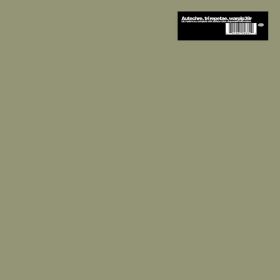Tri Repetae: Difference between revisions
Jump to navigation
Jump to search
(→C/Pach: cowbell) |
m (→Credits) |
||
| Line 97: | Line 97: | ||
* [[Chris Cunningham]] (design) | * [[Chris Cunningham]] (design) | ||
* Russell Haswell (design) | * Russell Haswell (design) | ||
* [[The Designers Republic]] (design) | * [[The Designers Republic]] (design) [https://www.discogs.com/master/2339-Autechre-Tri-Repetae] | ||
Revision as of 09:14, 8 February 2024
Tri Repetae
|
||||||
|
Tri Repetae is the third studio album by Autechre released on Warp Records. It was originally released on November 6th, 1995, then later repressed on vinyl in 2016, alongside Incunabula, and Amber.
Tracks
Dael
Clipper
- "Clipper" possibly used the Alesis MMT-8.
- "Clipper" appeared in Tri repetour shows. (example)
- "Clipper" was licensed out to be used in Volkswagen's New Beetle Isotope Green Commercial. [2]
Leterel
- An early version of "Leterel" appeared on Warp Tapes 89-93 as a segment in Part 2. In the Sean Twitch AMA, July 2022, Sean not only confirmed that it appeared in Warp Tapes, but also in AE_LIVE 2016/2018 where the track was heavily retooled. [3]
Rotar
Stud
Eutow
- An extended version of "Eutow" combined with "Basscadet" from Incunabula and "Djarum" from Anti appeared in their 1995-1996 live shows. (example)
- In 2001, Alex Rutherford made an unofficial music video on Channel 4's Lo-fi programme. As of writing, the video has yet to resurface.
C/Pach
- The cowbell on "C/Pach" was done by using the EPS-16+ to loop a bit of reverb on the sample and then pitch bending it. [4]
Gnit
Overand
- "Overand" uses the Roland CR-8000 on the drums.[5] Sean also mentioned that he main riff was a "dx100 sound with a fairly short decay, low sustain (i think 0) and the release set rly long" with possibly RSD-10 used for delay, and the background high-end sounds were achieved by creating aliasing effects on a resonant 202 a Quadraverb patch with cutoff set above its Nyquist. [6]
- "Overand" was used as the opening track in the workprint for the film "One Hour Photo", but was later replaced in the final version.[7]
Rsdio
- The track name, “Rsdio” is a reference to the BOSS RSD-10 Sampler/Delay unit. According to Sean in the WATMM Ask Autechre Anything, the main loop of the sound is a click fed through the RSD-10. [8]
Medrey
Tracklist
| # | Title | Length |
|---|---|---|
| 1 | Dael | 6:40 |
| 2 | Clipper | 8:34 |
| 3 | Leterel | 7:08 |
| 4 | Rotar | 8:04 |
| 5 | Stud | 9:41 |
| 6 | Eutow | 4:16 |
| 7 | C/Pach | 4:39 |
| 8 | Gnit | 5:50 |
| 9 | Overand | 7:33 |
| 10 | Rsdio | 10:08 |
| 1:12:33 | ||
| 11 | Medrey (Japanese CD exclusive) | 4:12 |
| Total | 1:16:46 | |
Trivia
- Some of the equipment used for Tri Repetae include the R8, Juno, 202, MS-10 Korg, Quadraverb, Ensoniq EPS, Atari 1040 running C-Lab Creator, Boss RSD-10, and possibly the 606.[9]
- Tri repetae translates to "three times" in Latin.
- Tri Repetae is the first Autechre album to have a bonus track for the Japanese CD release.
- Tri Repetae is the first Autechre album to have its title include a numerical reference to the album's placement in the discography (tri = three). Other subsequent records which also clearly reference the placement number in the title include LP5, Draft 7.30 and Exai.
- The sticker on the CD issue reads "Incomplete without surface noise"[10] while the sticker on the vinyl issue reads "Complete with surface noise."[11]
- The Designers Republic initially used reference shots of the machinery from Chris Cunningham's Second Bad Vilbel music video which were then heavily modified in Photoshop to make much of the designs present in the inner sleeves of Tri Repetae's packaging. The final album cover however was collectively decided by both Autechre and TDR to instead be a "totally plain metallic (technology) green (nature) cover (somewhere between Beatles White and Prince's Black)." [12]
Links
Credits
- Autechre (production)
- Rob Brown (writer)
- Sean Booth (writer)
- Chris Cunningham (design)
- Russell Haswell (design)
- The Designers Republic (design) [13]
